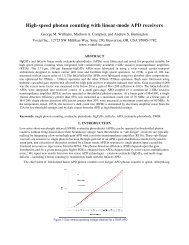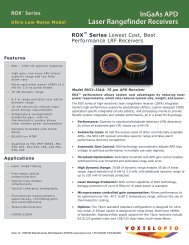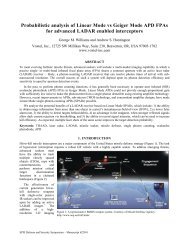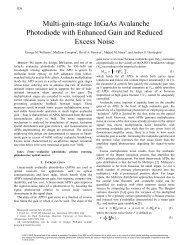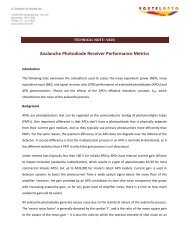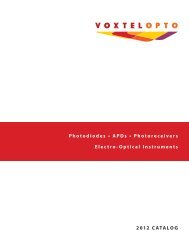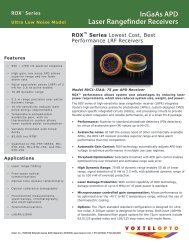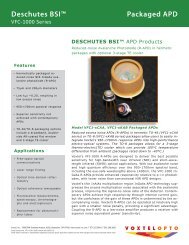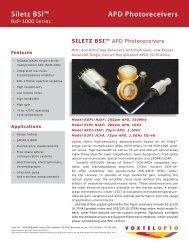Characterization of HgCdTe MWIR Back-Illuminated II-VI-07 ... - Voxtel
Characterization of HgCdTe MWIR Back-Illuminated II-VI-07 ... - Voxtel
Characterization of HgCdTe MWIR Back-Illuminated II-VI-07 ... - Voxtel
- No tags were found...
Create successful ePaper yourself
Turn your PDF publications into a flip-book with our unique Google optimized e-Paper software.
Noise measurements were done at <strong>Voxtel</strong>, Inc. A Test Chip from film 163, packaged in a flatpack,<br />
was mounted inside a windowed vacuum cryochamber. Stable, switchable flood illumination is projected<br />
through the window with an OZ Optics OZ-2000 1550 nm stabilized fiber-coupled diode laser. Bias voltage<br />
is applied to the diode by an HP4145A semiconductor parameter analyzer (SPA). A bias-T couples the DC<br />
component <strong>of</strong> the diode current to the SPA, and sends the AC component to an HP8447D high-speed preamp.<br />
The preamp can feed either a spectrum analyzer or a noise figure meter. In this way, both the average gain<br />
(calculated in the usual way from the DC component <strong>of</strong> the photocurrent) and the noise power spectral<br />
intensity at a given frequency and bias voltage can be read simultaneously. An HP8566B spectrum analyzer<br />
is used to choose frequency bands with low environmental noise, and an HP8970B noise figure meter makes<br />
calibrated noise power measurements.<br />
Noise power measurements are taken both in the dark and under illumination. By subtracting the<br />
noise power <strong>of</strong> the dark current, the noise power <strong>of</strong> the photocurrent can be isolated. This allows one to<br />
measure the multiplication noise and reject environmental noise. The HP8970B noise figure meter outputs<br />
noise power spectral intensity (S P in W/Hz), and the impedance <strong>of</strong> the test circuit must be found to convert<br />
these measurements to noise current spectral intensity (S I in A²/Hz). We use the noise measurement at unity<br />
gain (low bias voltage) for this normalization, rather than a measurement <strong>of</strong> the diode impedance in isolation,<br />
because this gives the most direct measurement <strong>of</strong> the relevant impedance – including effects from the<br />
mounting <strong>of</strong> the detector, its interaction with the preamplifier and noise figure meter, and anything specific to<br />
the frequency band used for the noise power measurement. The normalization is accomplished using<br />
Schottky’s theorem, S I = 2 q I (A²/Hz), along with a direct measurement <strong>of</strong> the DC photocurrent I PH :<br />
R = S P / S I = S P / (2 q I PH ) (3)<br />
Between 20 and 30 independent measurements <strong>of</strong> the light and dark noise power at unity gain are used to find<br />
R. Subsequently, noise current spectral intensity S I is measured at a variety <strong>of</strong> different values <strong>of</strong> M, taking<br />
10 independent measurements <strong>of</strong> light and dark noise power for each gain point. Finally, excess noise factor<br />
F(M) is calculated using the noise current spectral intensity theorem for avalanche multiplication:<br />
-13-




